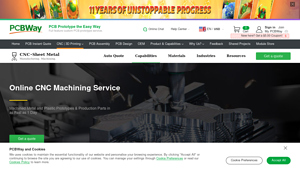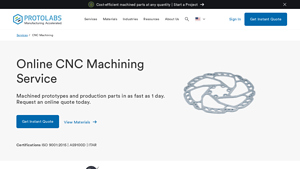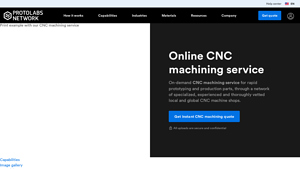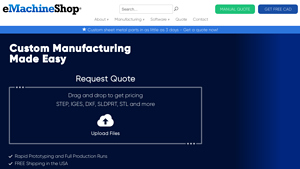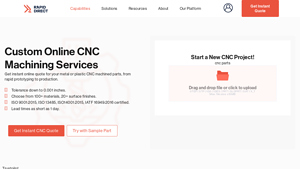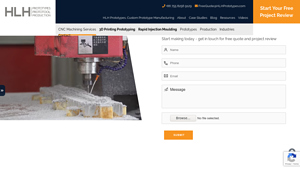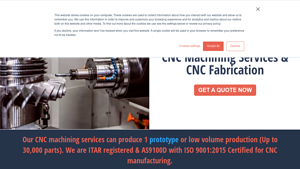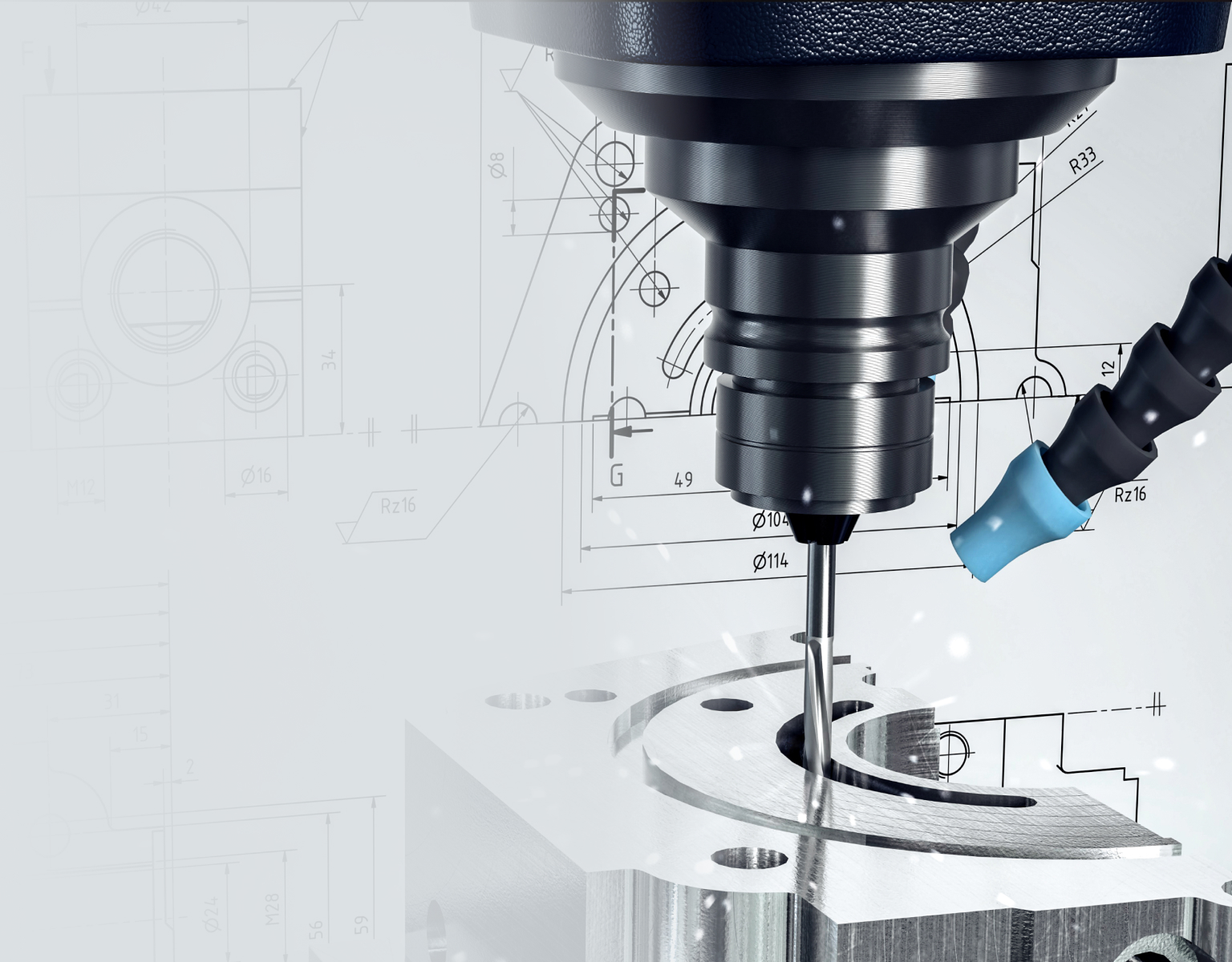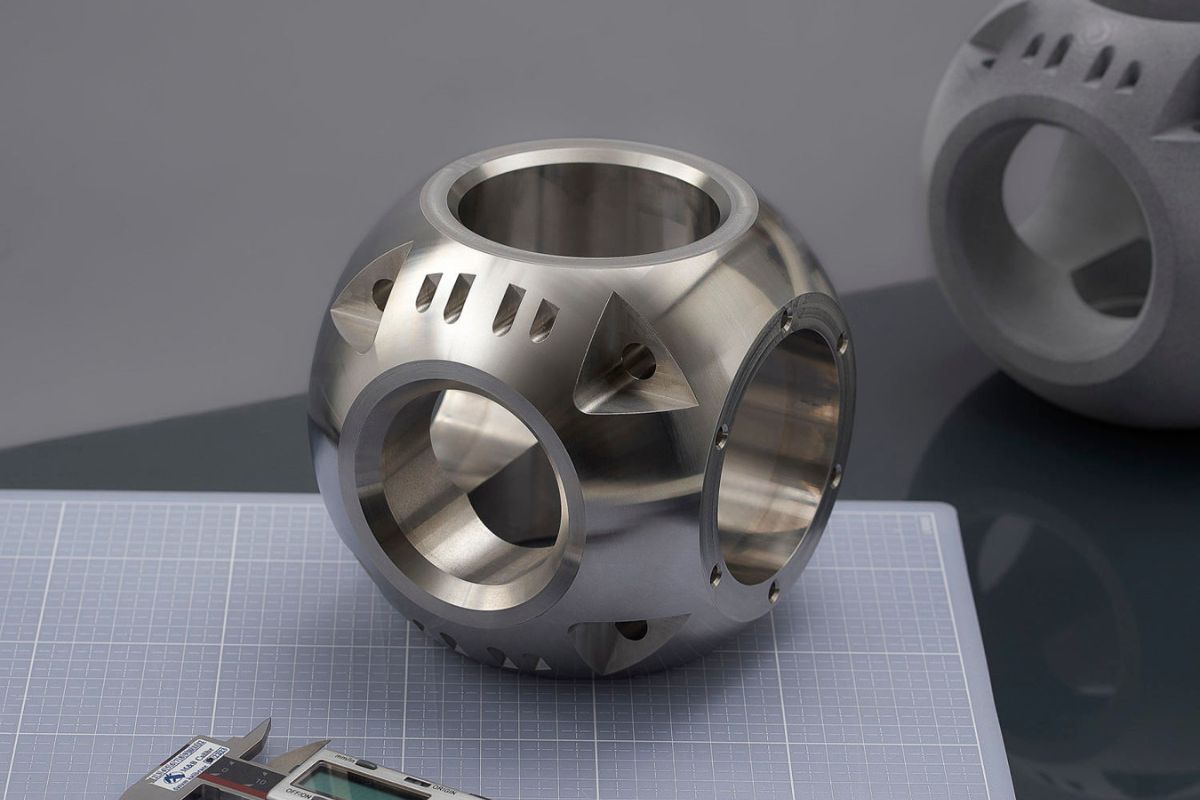Top 8 Cnc Machining Prototype Service List and Guide
Top 8 Cnc Machining Prototype Service Manufacturers & Suppliers List
1. PCBWay – CNC Machining & Prototyping Services
Domain: pcbway.com
Registered: 2012 (13 years)
Introduction: CNC Machining Service includes precision CNC machining and rapid prototyping parts. Key features include CNC milling (3-, 4-, & full 5-axis), CNC turning, and various 3D printing technologies (FDM, SLA, SLS, MJF, DMLS, PolyJet). Materials used in CNC machining include metals (Aluminum, Stainless steel, Brass, Copper, Titanium, Mild steel, Alloy steel, Tool steel, Spring steel) and plastics (ABS, P…
2. Protolabs – CNC Machining Services
Domain: protolabs.com
Registered: 2006 (19 years)
Introduction: Online CNC Machining Service offering cost-efficient machined parts at any quantity. Machined prototypes and production parts available in as fast as 1 day. CNC Machining capabilities include CNC Milling (3-axis and 5-axis indexed), CNC Turning with live tooling. Materials include various metals (Aluminum, Brass, Copper, Stainless Steel, Steel Alloy, Mild Low Carbon, Titanium) and plastics (ABS, A…
3. Hubs – On-Demand CNC Machining Service
Domain: hubs.com
Registered: 1998 (27 years)
Introduction: Online CNC Machining Service: On-demand CNC machining service for rapid prototyping and production parts. Capabilities include CNC milling (3 & 5 axis), CNC turning, and access to over 1,000 milling centers and 300 turning centers. Tolerances down to ±.020 mm (±.001 in) and lead times from 5 business days. Materials include various metals (Aluminum, Brass, Copper, Stainless Steel, Titanium) and pl…
4. Dassault Systèmes – CNC Machining Service
Domain: 3ds.com
Registered: 1995 (30 years)
Introduction: CNC Machining Service by Dassault Systèmes® 3DEXPERIENCE Make is an on-demand manufacturing platform connecting designers and engineers with CNC machining service providers primarily in North America and Europe. The service supports small and large runs, including mockups and prototypes. Key features include an instant quote engine, secure payments, and protected intellectual property. The service…
5. eMachineShop – Custom Manufacturing Services
Domain: emachineshop.com
Registered: 1999 (26 years)
Introduction: eMachineShop offers custom manufacturing services including CNC machining, injection molding, 3D printing, and sheet metal fabrication. Key features include:
– Fast quotes and free CAD software.
– Custom sheet metal parts available in as little as 3 days.
– Supports various CAD file formats: STEP, IGES, DXF, SLDPRT, STL, AMF, CGR, HCG, HSF, IFC, PRT, PRTDOT, SAT, SLDLFP, VDA, WRL, XAML, X_B, OBJ.
…
6. RapidDirect – Custom CNC Machining Services
Domain: rapiddirect.com
Registered: 2010 (15 years)
Introduction: Online CNC Machining Services for Custom Parts, Instant CNC Quote, RapidDirect Capabilities include CNC Machining, CNC Milling, CNC Turning, Injection Molding, Plastic Injection Molding, Injection Mold Tooling, Sheet Metal Fabrication, 3D Printing, Vacuum Casting, Die Casting, Finishing Services, Rapid Prototyping, On-Demand Manufacturing Solutions. Industries served: Aerospace, Automotive, Consum…
7. HLH Prototypes – CNC Machining Services
Domain: hlhprototypes.com
Registered: 2012 (13 years)
Introduction: CNC Machining Services offered by HLH Prototypes include high-speed, high-precision manufacturing using a variety of materials (plastics and metals). The services utilize over 50 high precision CNC mills, lathes, sink and wire EDMs, and surface grinding machines. They provide 3, 4, and 5 axis machining capabilities and conform to ISO 2678-1 International Tolerance legislation. Applications include…
8. RCO Engineering – CNC Machining & Fabrication Services
Domain: rcoeng.com
Registered: 1996 (29 years)
Introduction: CNC Machining Services & CNC Fabrication, ITAR registered & AS9100D with ISO 9001:2015 Certified, low volume production (up to 30,000 parts), CNC milling (vertical & horizontal), CNC turning, CNC router, prototype CNC EDM, 3, 4, 5-axis machining (up to 110″ * 72″ * 40″), 7-axis lathe, 5-axis gun drill, ram EDM, materials: aluminum, brass, bronze, zinc, copper, titanium, carbon fiber (SMC), ren boa…
Introduction: Navigating the Global Market for cnc machining prototype service
In today’s global market, sourcing reliable CNC machining prototype services can be a daunting challenge for international B2B buyers. Companies across Africa, South America, the Middle East, and Europe (including regions like Saudi Arabia and Vietnam) often struggle with identifying trustworthy suppliers who can deliver precision-engineered prototypes on time and within budget. This guide aims to demystify the complexities of CNC machining by providing an in-depth exploration of various service types, applications, and critical factors for supplier vetting.
The CNC machining landscape encompasses a wide array of options—from milling and turning to advanced multi-axis machining—each suited for different industrial applications such as aerospace, medical devices, and consumer electronics. This guide will also delve into cost considerations, including pricing structures and tariffs that affect international procurement, ensuring that buyers can navigate financial implications effectively.
By equipping B2B buyers with actionable insights and a comprehensive understanding of the CNC machining prototype service sector, this resource empowers informed purchasing decisions. With the right knowledge, businesses can confidently select suppliers that align with their production needs and quality standards, ultimately facilitating smoother operations and enhanced product development.
Understanding cnc machining prototype service Types and Variations
| Type Name | Key Distinguishing Features | Primary B2B Applications | Brief Pros & Cons for Buyers |
|---|---|---|---|
| CNC Milling | Utilizes rotating cutting tools to remove material from a workpiece; available in 3, 4, and 5-axis options. | Aerospace, automotive, consumer products | Pros: High precision, versatility in materials. Cons: Longer lead times for complex parts. |
| CNC Turning | Involves rotating the workpiece against a stationary cutting tool, ideal for cylindrical parts. | Medical devices, automotive components | Pros: Excellent for round geometries, high efficiency. Cons: Limited to symmetrical designs. |
| CNC Routing | Uses a rotating bit to cut and shape materials, often used for larger sheets and non-metal materials. | Signage, furniture, and packaging industries | Pros: Great for large parts and soft materials. Cons: Less precision than milling for intricate designs. |
| CNC Laser Cutting | Employs a high-powered laser to cut through materials with high accuracy; ideal for intricate designs. | Electronics, custom signage, and decorative items | Pros: High precision and speed, minimal material waste. Cons: Limited to thinner materials. |
| CNC 3D Printing | Combines CNC techniques with additive manufacturing for complex geometries; suitable for rapid prototyping. | Aerospace, healthcare, and custom tooling | Pros: Rapid prototyping and design flexibility. Cons: Material limitations compared to traditional CNC. |
What Are the Characteristics of CNC Milling Services?
CNC milling services are characterized by their ability to produce intricate parts using rotating cutting tools. This method is suitable for a wide range of materials, including metals and plastics, making it a popular choice in industries like aerospace and automotive. Buyers should consider the specific tolerances required for their projects, as complex designs may lead to longer lead times. Additionally, understanding the machine’s capabilities (3, 4, or 5-axis) can influence the decision-making process.
How Does CNC Turning Differ from Other Machining Services?
CNC turning is distinct in that it focuses on creating cylindrical parts by rotating the workpiece against a fixed cutting tool. This method excels in producing high volumes of symmetrical components, making it ideal for applications in the medical and automotive sectors. Buyers must evaluate the geometric complexity of their designs, as CNC turning is limited to round shapes. Cost-effectiveness and speed are significant advantages when high-volume production is required.
What Are the Benefits of CNC Routing for Large Projects?
CNC routing is designed for larger sheets of materials and is particularly effective for softer substrates like wood, plastics, and composites. This service is frequently utilized in the signage and furniture industries, where large and intricate designs are common. While routing offers significant advantages in terms of size and speed, buyers should be aware that it may not achieve the same precision as milling for complex geometric shapes. Understanding the material properties is crucial for optimal results.
When Should You Consider CNC Laser Cutting?
CNC laser cutting is ideal for applications requiring high precision and speed, particularly in thinner materials. This technique is widely used in the electronics industry and for custom signage. Its ability to create intricate designs with minimal waste makes it an attractive option for buyers seeking efficiency. However, it is essential to note that laser cutting may not be suitable for thicker materials, which could limit its application in certain projects.
How Does CNC 3D Printing Enhance Prototype Development?
CNC 3D printing merges traditional CNC machining with additive manufacturing, allowing for the rapid production of complex geometries. This service is particularly beneficial in industries like aerospace and healthcare, where prototyping speed and design flexibility are critical. Buyers should consider the material options and the specific requirements of their prototypes, as some advanced materials may not be compatible with traditional CNC processes. The ability to iterate quickly on designs is a significant advantage in fast-paced markets.
Key Industrial Applications of cnc machining prototype service
| Industry/Sector | Specific Application of CNC Machining Prototype Service | Value/Benefit for the Business | Key Sourcing Considerations for this Application |
|---|---|---|---|
| Aerospace | Production of lightweight, high-precision components | Enhanced performance and fuel efficiency in aircraft design | Certification requirements (e.g., AS9100), material sourcing, and lead times |
| Automotive | Development of custom engine parts and prototypes | Improved engine performance and reduced production costs | Compliance with industry standards (e.g., IATF 16949), rapid prototyping capabilities, and material options |
| Medical Device | Manufacturing of surgical instruments and implants | High precision and compliance with stringent regulations | ISO certifications, biocompatible materials, and traceability of components |
| Consumer Electronics | Creation of enclosures and components for devices | Faster time-to-market for new products | Design flexibility, rapid turnaround, and cost efficiency |
| Robotics | Fabrication of custom parts for robotic systems | Enhanced functionality and adaptability in robotic design | Precision machining capabilities, material variety, and scalability of production |
How is CNC Machining Prototype Service Used in Aerospace?
In the aerospace industry, CNC machining prototype services are critical for producing lightweight, high-precision components such as brackets, housings, and structural elements. These components must meet stringent safety and performance standards, making accuracy paramount. By leveraging CNC technology, manufacturers can create prototypes that undergo rigorous testing before full-scale production, ensuring they meet compliance with AS9100 certification. International buyers should consider sourcing from suppliers with proven experience in aerospace applications and robust quality assurance processes.
What Role Does CNC Machining Play in Automotive Development?
CNC machining services are integral to the automotive sector, particularly for developing custom engine parts, transmission components, and specialized tooling. These prototypes allow manufacturers to test designs and functionality before committing to mass production, leading to significant cost savings. Buyers from regions like South America and Africa should prioritize suppliers who offer rapid prototyping and can ensure compliance with IATF 16949 standards, which govern quality management systems in the automotive industry.
Why is CNC Machining Important for Medical Device Manufacturing?
In the medical device sector, CNC machining prototype services are utilized to produce surgical instruments, implants, and other critical components that require high precision and biocompatibility. These prototypes must adhere to strict regulatory standards, such as ISO 13485, to ensure patient safety. International buyers must focus on sourcing from manufacturers who can provide certifications and traceability for materials used, particularly in regions where regulatory scrutiny is high, such as Europe and the Middle East.
How Does CNC Machining Facilitate Consumer Electronics Production?
The consumer electronics industry benefits from CNC machining prototype services by enabling the rapid creation of enclosures and internal components for devices like smartphones and wearables. This technology allows for quick iterations on design, helping companies to bring products to market faster. Buyers should seek suppliers who can offer flexibility in design and a range of materials, ensuring that prototypes align with the latest trends and consumer demands while maintaining cost efficiency.
In What Ways is CNC Machining Used in Robotics?
CNC machining plays a vital role in the robotics industry by facilitating the fabrication of custom parts that enhance the functionality and adaptability of robotic systems. From precision gears to structural frames, these prototypes are essential for testing and refining designs before full production. Buyers, especially from emerging markets, should consider sourcing from suppliers that can provide diverse material options and scalability to accommodate the rapidly evolving robotics landscape.
3 Common User Pain Points for ‘cnc machining prototype service’ & Their Solutions
Scenario 1: Navigating Long Lead Times for Prototypes
The Problem: For many international B2B buyers, particularly those in fast-paced industries like electronics or automotive, the lengthy lead times associated with CNC machining prototypes can be a significant hurdle. When a buyer places an order, they often need the prototypes quickly to meet market demands or internal project deadlines. Delays can result in missed opportunities, increased costs, and a loss of competitive edge, especially when collaborating with suppliers who may not have streamlined processes in place.
The Solution: To mitigate long lead times, buyers should prioritize sourcing CNC machining services that offer rapid prototyping capabilities. Look for providers with a robust online quoting system that allows for instant pricing and timelines. For example, platforms like Xometry provide an Instant Quoting Engine, which not only gives quotes but also offers feedback on design-for-manufacturability. Additionally, establishing a clear communication line with the service provider can help ensure that any potential delays are identified and addressed early in the process. Implementing a project management tool to track orders and deadlines can also facilitate smoother communication and keep projects on schedule.
Scenario 2: Quality Assurance and Consistency Concerns
The Problem: B2B buyers often face challenges regarding the quality and consistency of CNC machined prototypes. Variability in production quality can lead to significant issues down the line, especially if the prototypes are intended for rigorous applications in sectors like aerospace or medical devices. Buyers may experience anxiety over whether the finished parts will meet the necessary specifications and tolerances, which can jeopardize their projects or lead to costly rework.
The Solution: To alleviate concerns about quality assurance, buyers should engage with CNC machining services that are certified under relevant quality management standards, such as ISO 9001 or AS9100D. Requesting detailed documentation such as material certifications, quality control reports, and inspection data can further ensure that the prototypes meet specified standards. It’s also beneficial to establish a relationship with a supplier who is willing to accommodate initial prototypes with rigorous testing and adjustments based on feedback. This proactive approach not only builds trust but also enhances the overall quality of the final products.
Scenario 3: Complexity in Design Specifications
The Problem: Many B2B buyers encounter difficulties when trying to convey complex design specifications for CNC machined prototypes. This challenge is often exacerbated when dealing with suppliers who may not fully understand the nuances of the buyer’s industry or specific application requirements. Miscommunication can lead to prototypes that do not meet expectations, resulting in wasted resources and time.
The Solution: To overcome this issue, buyers should invest time in creating detailed, clear, and comprehensive CAD models and technical drawings that outline all necessary specifications, tolerances, and materials. Utilizing a platform that supports collaboration can enhance communication with the CNC machining service. Tools like CAD file upload options, along with a dedicated support team, can help clarify any uncertainties. Additionally, involving the machining service early in the design phase can provide valuable insights and recommendations that enhance manufacturability and ensure that the prototypes align with the buyer’s vision. Regular check-ins throughout the production process can also help ensure that the project stays on track and meets the desired outcomes.
Strategic Material Selection Guide for cnc machining prototype service
What Are the Key Properties of Aluminum in CNC Machining Prototypes?
Aluminum is one of the most commonly used materials in CNC machining due to its favorable properties. It exhibits excellent corrosion resistance, lightweight characteristics, and good thermal and electrical conductivity. Aluminum can withstand moderate temperatures, making it suitable for various applications, including automotive and aerospace components. Its machinability allows for complex geometries, making it ideal for prototype development.
What Are the Pros and Cons of Using Aluminum?
The advantages of aluminum include its low density, which reduces the overall weight of the final product, and its cost-effectiveness in large-scale production. However, it has lower strength compared to some metals like steel, which may limit its use in high-stress applications. Additionally, while aluminum is relatively easy to machine, it can be more challenging to achieve tight tolerances due to its softer nature.
How Does Aluminum Impact Application Compatibility?
Aluminum’s corrosion resistance makes it suitable for applications exposed to moisture or chemicals. It is commonly used in industries such as automotive, aerospace, and consumer electronics. However, buyers should consider its compatibility with specific media, especially in chemical processing applications, where certain alloys may perform better than others.
What Should International Buyers Consider When Choosing Aluminum?
For international buyers, particularly from regions like Africa, South America, the Middle East, and Europe, compliance with standards such as ASTM and DIN is crucial. Additionally, understanding the specific alloy grades available in their region can impact the procurement process. Buyers should also consider the availability of aluminum machining services in their area to ensure timely delivery.
How Do Steel Alloys Perform in CNC Machining Prototypes?
Steel alloys, including stainless steel and tool steel, are known for their exceptional strength and durability. They exhibit high-temperature resistance and excellent wear properties, making them suitable for demanding applications. Stainless steel, in particular, offers superior corrosion resistance, while tool steel is designed for high hardness and wear resistance.
What Are the Advantages and Disadvantages of Steel Alloys?
The primary advantage of steel alloys is their strength, which allows for the production of robust components. However, they can be more expensive than aluminum and may require more complex machining processes, leading to higher production costs. Additionally, the weight of steel can be a disadvantage in applications where weight savings are critical.
How Do Steel Alloys Affect Application Performance?
Steel alloys are widely used in industries such as aerospace, automotive, and medical devices due to their high performance under stress. Their ability to withstand extreme conditions makes them suitable for applications involving high pressure or temperature. However, buyers should consider the specific type of steel alloy required for their application to ensure optimal performance.
What Considerations Should International Buyers Keep in Mind for Steel Alloys?
International buyers should be aware of the various steel grades and standards, such as ASTM and ISO, that apply to their specific applications. Additionally, shipping costs and tariffs can significantly impact the overall cost of procurement, especially for heavier materials like steel. Understanding local machining capabilities is also vital for ensuring quality and timely delivery.
What Are the Benefits of Using Plastics in CNC Machining Prototypes?
Plastics, such as ABS, polycarbonate, and nylon, are increasingly popular in CNC machining due to their versatility and lightweight properties. They offer good chemical resistance and can be engineered to meet specific performance criteria, such as impact resistance or flexibility. Plastics can be machined to intricate designs, making them suitable for prototypes in various industries.
What Are the Pros and Cons of Plastics in CNC Machining?
The advantages of using plastics include their lower cost compared to metals and their ease of machining. They can be produced quickly and in large quantities, making them ideal for rapid prototyping. However, plastics generally have lower strength and temperature resistance than metals, which may limit their use in high-stress applications.
How Do Plastics Impact Application Suitability?
Plastics are commonly used in consumer electronics, automotive interiors, and medical devices due to their lightweight and insulating properties. However, buyers must consider the specific environmental conditions the final product will face, as some plastics may degrade under UV exposure or high temperatures.
What Should International Buyers Consider When Selecting Plastics?
For international buyers, understanding the specific plastic grades and their compliance with industry standards is essential. Additionally, factors such as sourcing and availability can vary by region, impacting lead times and costs. Buyers should also consider the environmental regulations in their region that may affect the use of certain plastics.
Summary Table of Material Selection for CNC Machining Prototypes
| Material | Typical Use Case for cnc machining prototype service | Key Advantage | Key Disadvantage/Limitation | Relative Cost (Low/Med/High) |
|---|---|---|---|---|
| Aluminum | Automotive parts, aerospace components | Lightweight and corrosion-resistant | Lower strength compared to steel | Medium |
| Steel Alloys | Aerospace, automotive, medical devices | High strength and durability | Higher cost and complex machining | High |
| Plastics | Consumer electronics, automotive interiors | Cost-effective and versatile | Lower strength and temperature resistance | Low |
In-depth Look: Manufacturing Processes and Quality Assurance for cnc machining prototype service
What Are the Main Stages of Manufacturing in CNC Machining Prototype Services?
The manufacturing process for CNC (Computer Numerical Control) machining prototypes involves several key stages that ensure precision and quality. These stages include material preparation, forming, assembly, and finishing.
How is Material Prepared for CNC Machining?
Material preparation is the first critical step in the CNC machining process. It begins with selecting the appropriate material based on the prototype’s intended application. Common materials used include metals like aluminum, stainless steel, and brass, as well as various plastics such as polycarbonate and nylon.
Once the material is chosen, it is cut into manageable sizes, often referred to as “blanks.” This step may involve initial machining to create a uniform starting point. Quality control checks are typically performed at this stage to ensure that the material meets specified standards, such as thickness and hardness.
What Techniques Are Used in the Forming Stage?
The forming stage is where the actual shaping of the part occurs. CNC machines—such as mills, lathes, and routers—are employed to cut, drill, and engrave the material according to the specifications provided in the CAD (Computer-Aided Design) model.
Key techniques include:
- CNC Milling: Utilizes rotary cutters to remove material from a workpiece. This method is versatile and can produce complex geometries.
- CNC Turning: Involves rotating the workpiece against a stationary cutting tool to create cylindrical shapes.
- CNC Routing: Effective for creating intricate shapes and designs, especially in sheet materials.
Precision is paramount in this stage, as even minor deviations can lead to significant issues in the final product.
How is Assembly Conducted in CNC Machining?
In many cases, CNC machined parts may require assembly with other components. This can include fitting together multiple machined parts or integrating electronic components.
Assembly processes can vary widely depending on the complexity of the product. Techniques may involve mechanical fastening, welding, or adhesive bonding. A thorough inspection is conducted post-assembly to ensure that all components fit and function correctly, adhering to the design specifications.
What Finishing Techniques Are Commonly Used?
Finishing is the final stage in the manufacturing process and plays a crucial role in the aesthetic and functional characteristics of the prototype. Common finishing techniques include:
- Surface Treatments: Such as anodizing, plating, or painting to enhance corrosion resistance and appearance.
- Polishing: To achieve a smooth finish that can improve functionality and aesthetics.
- Deburring: The removal of sharp edges and imperfections to ensure safety and performance.
Quality control checks are performed after finishing to confirm that the surface finish meets the required specifications.
How is Quality Assurance Managed in CNC Machining Prototype Services?
Quality assurance (QA) is integral to the CNC machining process, ensuring that the final product meets industry standards and customer expectations.
What International Standards Are Relevant for CNC Machining?
International standards play a vital role in maintaining quality across different regions and industries. Key standards include:
- ISO 9001: A quality management standard that demonstrates a commitment to consistent quality.
- ISO 13485: Specific to medical devices, ensuring that products meet regulatory requirements.
- IATF 16949: Focused on the automotive sector, emphasizing continual improvement and defect prevention.
These certifications indicate that a supplier adheres to rigorous quality management processes, which is crucial for B2B buyers.
What Are the Key Quality Control Checkpoints?
Quality control checkpoints throughout the manufacturing process include:
- Incoming Quality Control (IQC): Inspection of raw materials to ensure they meet specified standards before production begins.
- In-Process Quality Control (IPQC): Ongoing inspections during the machining process to identify any deviations early on.
- Final Quality Control (FQC): Comprehensive testing of the finished product to confirm it meets all specifications before delivery.
These checkpoints help to catch potential issues at various stages, reducing the risk of defects in the final product.
What Testing Methods Are Commonly Used?
Common testing methods in CNC machining quality assurance include:
- Dimensional Inspection: Using calipers, gauges, and coordinate measuring machines (CMM) to verify that parts meet specified dimensions.
- Material Testing: Analyzing material properties such as tensile strength and hardness to ensure they align with requirements.
- Functional Testing: Verifying that the prototype performs as intended in its intended application.
How Can B2B Buyers Verify Supplier Quality Control?
B2B buyers must ensure that their suppliers maintain high-quality standards. Here are several ways to verify quality control:
What Role Do Audits and Reports Play?
Conducting audits of potential suppliers can provide insight into their quality management systems and processes. Buyers should request recent quality assurance reports that outline performance metrics, defect rates, and compliance with international standards.
How Important Are Third-Party Inspections?
Utilizing third-party inspection services can add an additional layer of assurance. These independent firms can conduct thorough assessments of the manufacturing process and final products, providing unbiased reports on quality.
What Are the Quality Control Nuances for International B2B Buyers?
For international buyers, understanding regional regulations and certifications is crucial. Different countries may have specific requirements for product quality and safety.
- Regional Standards: Buyers from Africa, South America, the Middle East, and Europe should familiarize themselves with local regulations that may impact quality assurance processes.
- Documentation Requirements: Ensuring that suppliers provide necessary documentation, such as material certifications and compliance certificates, can facilitate smoother transactions and reduce risks.
By paying close attention to these aspects, B2B buyers can make informed decisions when selecting CNC machining prototype service providers, ensuring that they receive high-quality products that meet their specific needs.
Practical Sourcing Guide: A Step-by-Step Checklist for ‘cnc machining prototype service’
Introduction
Sourcing CNC machining prototype services requires a systematic approach to ensure that your project meets quality standards while staying within budget and timelines. This guide provides a step-by-step checklist that will help B2B buyers, particularly those in Africa, South America, the Middle East, and Europe, navigate the complexities of procuring CNC machining services effectively.
Step 1: Define Your Technical Specifications
Before initiating contact with suppliers, clearly define your project’s technical specifications. This includes dimensions, tolerances, material requirements, and any specific finishes needed. Having detailed specifications helps ensure that suppliers provide accurate quotes and understand your project needs from the start.
Step 2: Research Potential Suppliers
Conduct thorough research to identify potential CNC machining service providers. Look for companies with a strong reputation in the industry, positive customer reviews, and relevant experience in your specific sector. Utilize platforms such as industry forums, LinkedIn, and trade shows to gather insights and recommendations.
Step 3: Verify Supplier Certifications
Certifications like ISO 9001:2015 and AS9100D indicate a supplier’s commitment to quality management and manufacturing excellence. Request copies of these certifications to ensure that the supplier adheres to international quality standards. This step is crucial to mitigate risks associated with subpar manufacturing processes.
Step 4: Evaluate Manufacturing Capabilities
Assess the supplier’s manufacturing capabilities to ensure they align with your project requirements. Inquire about the types of CNC machines they use (e.g., 3-axis, 5-axis), their production capacity, and the materials they can work with. Understanding their capabilities will help you determine if they can handle your project’s complexity and volume.
Step 5: Request Quotes and Compare Pricing
Once you have narrowed down your list of suppliers, request detailed quotes that include pricing, lead times, and payment terms. Compare these quotes not just on price, but also on the value offered, such as shipping costs, included services (like finishing), and post-production support. This comprehensive comparison will aid in making an informed decision.
Step 6: Conduct a Quality Assurance Review
Before finalizing a supplier, conduct a quality assurance review. Ask for samples of previous work or case studies that demonstrate their ability to meet quality standards. Additionally, inquire about their quality control processes and inspection methods to ensure that they maintain high-quality output consistently.
Step 7: Establish Clear Communication Channels
Effective communication is essential for the success of any project. Establish clear channels for ongoing dialogue with your chosen supplier to address questions, updates, and changes promptly. Ensure that there is a designated contact person who understands your project’s specifics, facilitating smoother interactions throughout the manufacturing process.
By following these steps, B2B buyers can streamline their sourcing process for CNC machining prototype services, ensuring that they partner with the right suppliers to achieve their production goals efficiently and effectively.
Comprehensive Cost and Pricing Analysis for cnc machining prototype service Sourcing
What Are the Key Cost Components in CNC Machining Prototype Services?
Understanding the cost structure of CNC machining prototype services is essential for B2B buyers. The primary cost components include:
-
Materials: The choice of materials significantly affects costs. Common materials such as aluminum and plastic are generally more affordable, while high-performance materials like titanium and advanced plastics can lead to higher expenses.
-
Labor: Skilled labor is required for operating CNC machines and programming tool paths. Labor costs can vary based on the complexity of the machining required and the local market rates in the supplier’s region.
-
Manufacturing Overhead: This includes costs related to equipment maintenance, utilities, and facility expenses. Overhead can fluctuate based on the supplier’s operational efficiency and location.
-
Tooling: Specialized tooling is often necessary for complex designs. The initial investment in tooling can be significant, but it is typically amortized over larger production runs.
-
Quality Control (QC): Ensuring the precision and reliability of machined parts involves quality assurance processes. Certifications (e.g., ISO 9001) and inspection protocols add to the overall cost but are critical for industries requiring stringent compliance.
-
Logistics: Shipping and handling costs are particularly relevant for international buyers. These can vary based on distance, shipping method, and potential tariffs.
-
Margin: Suppliers will include a profit margin in their pricing, which can vary widely based on their business model and market positioning.
How Do Price Influencers Affect CNC Machining Costs?
Several factors can influence the pricing of CNC machining services:
-
Volume and Minimum Order Quantity (MOQ): Larger orders often benefit from economies of scale, resulting in lower per-unit costs. Conversely, small batch orders may incur higher prices due to setup costs.
-
Specifications and Customization: Highly customized parts with intricate designs typically command higher prices. Standardized components are generally less expensive.
-
Material Selection: As mentioned, the choice of materials plays a crucial role in pricing. Buyers should consider the trade-off between cost and performance.
-
Quality and Certifications: Parts requiring higher quality standards or specific certifications will incur additional costs. Suppliers with robust quality management systems may charge a premium for their services.
-
Supplier Factors: Location, reputation, and capabilities of the supplier can affect pricing. Established suppliers may have higher prices due to their proven track record and quality assurance processes.
-
Incoterms: Understanding the delivery terms (e.g., FOB, CIF) can impact the total cost. Buyers should clarify responsibilities for shipping costs, insurance, and tariffs.
What Are the Best Buyer Tips for Negotiating CNC Machining Prices?
B2B buyers can employ several strategies to negotiate better pricing for CNC machining services:
-
Evaluate Total Cost of Ownership: Consider not just the initial price but also long-term costs, including maintenance, potential rework, and logistics. A higher upfront cost may result in lower overall expenses if the quality is superior.
-
Leverage Volume Discounts: If your business plans to place large orders, use this to negotiate for better rates. Suppliers are often willing to offer discounts for bulk purchases.
-
Request Detailed Quotes: Ensure that quotes include a breakdown of costs. This transparency allows for better comparisons and highlights areas where negotiation may be possible.
-
Explore Multiple Suppliers: Don’t settle for the first quote. Engaging multiple suppliers can lead to competitive pricing and better service options.
-
Be Aware of International Pricing Nuances: For buyers in Africa, South America, the Middle East, and Europe, it’s essential to understand local market conditions, currency fluctuations, and import duties that may affect overall costs.
Conclusion: Are There Indicative Prices for CNC Machining Prototype Services?
While indicative prices can vary widely based on the factors mentioned above, understanding the cost components and pricing influencers can help international B2B buyers make informed decisions. Each project is unique, and potential buyers should conduct thorough research and engage in open discussions with suppliers to arrive at the best pricing structure suited to their needs.
Alternatives Analysis: Comparing cnc machining prototype service With Other Solutions
Understanding Alternatives to CNC Machining Prototype Services
In the realm of manufacturing, particularly for prototypes, CNC machining services are a popular choice due to their precision and versatility. However, various alternatives exist that can cater to different project requirements, timelines, and budgets. This analysis will compare CNC machining with two viable alternatives: 3D printing and injection molding. Each method has unique advantages and challenges that can significantly influence a buyer’s decision based on their specific needs.
Comparison Table
| Comparison Aspect | CNC Machining Prototype Service | 3D Printing | Injection Molding |
|---|---|---|---|
| Performance | High precision and detail | Moderate precision, layer-based | High volume, excellent detail |
| Cost | Moderate to high | Low to moderate (for small runs) | High initial investment |
| Ease of Implementation | Requires CAD files and setup | User-friendly, quick setup | Complex, requires molds |
| Maintenance | Low maintenance, regular checks | Minimal maintenance | High maintenance for molds |
| Best Use Case | Complex parts, metal components | Rapid prototyping, low volumes | Mass production of plastic parts |
Detailed Breakdown of Alternatives
3D Printing: What Are Its Advantages and Drawbacks?
3D printing, also known as additive manufacturing, allows for the rapid creation of prototypes directly from CAD files. It is especially effective for creating complex geometries that may be difficult to achieve with traditional methods. The ease of setup and flexibility in design makes 3D printing a popular choice for small-batch production and one-off prototypes. However, the layer-by-layer construction can lead to lower surface quality compared to CNC machining, and it may not be suitable for all materials, particularly metals.
Injection Molding: When Is It the Right Choice?
Injection molding is ideal for producing high volumes of plastic parts with consistent quality. It is highly efficient for mass production once the initial mold is created. This method excels in creating intricate designs with excellent surface finish and dimensional accuracy. However, the initial setup cost for mold creation can be quite high, making it less feasible for small runs or prototypes. Moreover, the process can be time-consuming, as it requires careful planning and design of the molds.
Conclusion: How Should B2B Buyers Choose the Right Solution?
When selecting the right manufacturing solution, B2B buyers must assess their specific needs, including the complexity of the design, production volume, budget constraints, and material requirements. CNC machining is best for high-precision and complex metal parts, while 3D printing is suitable for rapid prototyping and low-volume production. Conversely, injection molding shines in mass production scenarios where cost efficiency and quality consistency are paramount. By aligning project goals with the strengths and weaknesses of each method, buyers can make informed decisions that drive their product development forward efficiently.
Essential Technical Properties and Trade Terminology for cnc machining prototype service
What Are the Key Technical Properties in CNC Machining Prototype Services?
Understanding the essential technical specifications in CNC machining is crucial for B2B buyers aiming to procure high-quality prototypes. Here are some critical specifications to consider:
1. Material Grade
Material grade refers to the specific classification of the material used in CNC machining, such as aluminum, stainless steel, or various plastics. Each grade has distinct mechanical properties, such as strength, ductility, and corrosion resistance. Selecting the appropriate material grade is vital for ensuring the final product meets performance requirements in its intended application, whether in aerospace, automotive, or consumer electronics.
2. Tolerance
Tolerance defines the permissible limit of variation in a physical dimension. It is a critical specification that ensures parts fit together correctly and function as intended. Common tolerance values in CNC machining can range from ±0.005 inches to ±0.001 inches, depending on the complexity and requirements of the project. Accurate tolerances are essential for industries where precision is non-negotiable, such as medical devices and aerospace components.
3. Surface Finish
Surface finish refers to the texture and quality of a part’s surface after machining. Common finishes include as-milled, bead blasted, anodized, and polished. The choice of surface finish can affect not only aesthetics but also functionality, such as wear resistance and corrosion protection. Understanding surface finish specifications is crucial for B2B buyers to ensure that the final product meets both aesthetic and functional standards.
4. Dimensional Stability
Dimensional stability indicates how well a material maintains its shape and size under various environmental conditions. It is particularly important for components that will undergo significant temperature fluctuations or stress during their lifecycle. Selecting materials with high dimensional stability can minimize the risk of warping or deformation, ensuring that parts perform consistently in their applications.
5. Production Volume
Production volume refers to the quantity of parts produced in a single run. This specification helps determine the most suitable manufacturing process and affects cost. Low-volume production is often more costly per unit due to setup time, while high-volume runs can benefit from economies of scale. Understanding the implications of production volume is crucial for aligning manufacturing capabilities with business needs.
What Are Common Trade Terms in CNC Machining Prototype Services?
Familiarity with industry jargon can streamline communication between buyers and suppliers. Here are some common terms that every B2B buyer should know:
1. OEM (Original Equipment Manufacturer)
An OEM is a company that produces parts or equipment that may be marketed by another manufacturer. In CNC machining, OEMs often provide prototypes for products that will be branded and sold by other companies. Understanding OEM relationships is essential for B2B buyers to ensure they are sourcing quality components that meet their specifications.
2. MOQ (Minimum Order Quantity)
MOQ refers to the smallest quantity of a product that a supplier is willing to sell. In CNC machining, suppliers may set MOQs based on production costs and operational efficiencies. Knowing the MOQ helps buyers plan their purchasing strategy and avoid overcommitting to unneeded inventory.
3. RFQ (Request for Quotation)
An RFQ is a formal document sent to suppliers requesting pricing and terms for specific products or services. For CNC machining prototypes, an RFQ typically includes detailed specifications, quantities, and timelines. Submitting a well-prepared RFQ can lead to more accurate quotes and better supplier relationships.
4. Incoterms (International Commercial Terms)
Incoterms are a set of predefined commercial terms published by the International Chamber of Commerce (ICC) that outline the responsibilities of buyers and sellers in international transactions. Understanding Incoterms is crucial for B2B buyers involved in cross-border CNC machining services, as they dictate shipping responsibilities, risk transfer, and cost allocation.
5. CAD (Computer-Aided Design)
CAD refers to the use of software to create precise drawings and technical illustrations of parts. In CNC machining, CAD files are essential for programming the CNC machines to manufacture parts accurately. Familiarity with CAD can enhance communication with suppliers and ensure that designs are interpreted correctly.
By understanding these technical properties and trade terms, B2B buyers can navigate the CNC machining landscape more effectively, ensuring that their prototype needs are met with precision and clarity.
Navigating Market Dynamics and Sourcing Trends in the cnc machining prototype service Sector
What Are the Key Market Trends Influencing CNC Machining Prototype Services?
The CNC machining prototype service sector is experiencing significant transformation driven by globalization, technological advancements, and changing buyer expectations. One of the primary global drivers is the growing demand for rapid prototyping, which allows businesses to accelerate product development cycles. This is particularly relevant for industries like aerospace, automotive, and consumer electronics, where time-to-market can determine competitive advantage. Emerging technologies, such as additive manufacturing and Industry 4.0 innovations, are enabling CNC machining providers to enhance precision and efficiency, thereby attracting international buyers from regions such as Africa, South America, the Middle East, and Europe.
Additionally, there is a notable trend towards customization and flexibility in sourcing. Many B2B buyers now prefer suppliers that can offer tailored solutions rather than one-size-fits-all products. This shift is facilitating the rise of online platforms that provide instant quotes and allow businesses to upload CAD files for quick turnarounds. In markets like Saudi Arabia and Vietnam, where manufacturing is burgeoning, the ability to scale production rapidly is becoming a crucial criterion for supplier selection. Furthermore, buyers are increasingly focusing on quality certifications, such as ISO and ITAR registrations, to ensure compliance and reliability in the supply chain.
How Is Sustainability Shaping the CNC Machining Prototype Service Sector?
In recent years, sustainability has emerged as a critical factor influencing B2B sourcing decisions within the CNC machining prototype service sector. Environmental concerns related to manufacturing processes, such as waste generation and resource consumption, are prompting buyers to seek suppliers that prioritize eco-friendly practices. This includes adopting cleaner technologies and utilizing sustainable materials, which can significantly reduce the carbon footprint of production.
Ethical sourcing is also gaining traction, with many businesses recognizing the importance of transparency and social responsibility in their supply chains. Buyers are increasingly looking for partners that adhere to ethical labor practices and maintain responsible sourcing standards. Certifications such as ISO 14001 (Environmental Management) and the use of ‘green’ materials—like recycled metals and biodegradable plastics—are becoming essential criteria for supplier evaluation. As companies strive to meet their corporate social responsibility goals, selecting CNC machining service providers that align with these values can enhance brand reputation and customer loyalty.
How Has the CNC Machining Prototype Service Evolved Over Time?
The evolution of CNC machining prototype services can be traced back to the introduction of computer numerical control technology in the mid-20th century. Initially limited to simple tasks, advancements in software and hardware have transformed CNC machines into highly sophisticated tools capable of executing complex designs with exceptional precision.
As global manufacturing trends shifted towards just-in-time production and lean methodologies, the demand for efficient prototyping solutions grew. The rise of digital design tools and the internet has further democratized access to CNC machining services, enabling businesses worldwide to leverage these technologies for rapid product development. Today, CNC machining is integral to numerous industries, showcasing its adaptability and continued relevance in an ever-evolving market landscape.
In summary, understanding these market dynamics and trends is crucial for international B2B buyers seeking to optimize their sourcing strategies in the CNC machining prototype service sector. By aligning with sustainable practices and leveraging technological advancements, companies can position themselves competitively in a rapidly changing marketplace.
Frequently Asked Questions (FAQs) for B2B Buyers of cnc machining prototype service
-
How do I select the right CNC machining service for my prototype needs?
Choosing the right CNC machining service involves assessing several factors. Start by evaluating the supplier’s capabilities and certifications, such as ISO 9001 or AS9100D, which ensure quality management. Review their material options, machining technologies, and turnaround times to match your project requirements. Additionally, consider their experience in your specific industry, customer reviews, and their ability to provide rapid prototyping and support during the design process. Lastly, request quotes from multiple suppliers to compare pricing and services. -
What materials are commonly used in CNC machining prototypes?
CNC machining can accommodate a wide range of materials, including metals like aluminum, stainless steel, and titanium, as well as various plastics such as ABS, nylon, and polycarbonate. The choice of material depends on your prototype’s intended application, mechanical properties, and budget. For example, aluminum is lightweight and cost-effective for many applications, while titanium offers superior strength for aerospace components. It’s crucial to discuss material options with your supplier to ensure they can meet your specifications and quality standards. -
What are the typical lead times for CNC machining prototypes?
Lead times for CNC machining prototypes can vary based on factors such as complexity, material availability, and the supplier’s workload. Generally, you can expect prototypes to be completed within a few days to a couple of weeks. Rapid prototyping services can expedite this process, often delivering parts in 48 to 72 hours. When placing an order, clarify the expected lead time with your supplier to ensure it aligns with your project deadlines. -
What is the minimum order quantity (MOQ) for CNC machining services?
The minimum order quantity (MOQ) for CNC machining services can vary significantly between suppliers. Some may offer prototyping services with no MOQ, allowing you to order just one part for testing, while others may require a minimum of 10 or more units. When sourcing a supplier, inquire about their MOQ policies, especially if you plan to scale production after prototyping, as this will impact your overall project costs. -
How can I ensure quality in my CNC machined prototypes?
To ensure quality in your CNC machined prototypes, start by selecting a supplier with robust quality assurance processes. Look for certifications such as ISO 9001, which indicates a commitment to quality management. Additionally, request detailed inspection reports and consider including specific quality checks in your contract. You may also want to discuss traceability and material certifications to confirm that the components meet your industry standards. -
What payment terms should I expect when sourcing CNC machining services internationally?
Payment terms for international CNC machining services can vary based on the supplier and your negotiation. Common options include upfront payments, partial payments before production, and net payment terms after delivery. It’s essential to clarify these terms during the negotiation phase to avoid any misunderstandings. Additionally, consider discussing currency exchange rates and transaction fees, as these can affect your overall costs. -
What logistics considerations should I keep in mind for international CNC machining orders?
When sourcing CNC machining services internationally, logistics play a crucial role. Be aware of shipping methods, delivery times, and customs regulations that may affect the import of your prototypes. Work with suppliers who have experience in international shipping and can provide inclusive pricing that covers tariffs and shipping costs. Additionally, consider your location’s proximity to the supplier, as this can impact lead times and overall shipping expenses. -
How do I communicate my design specifications effectively to a CNC machining supplier?
Effective communication of design specifications is vital for successful CNC machining. Start by providing detailed CAD files that illustrate your design accurately. Include dimensions, tolerances, surface finishes, and any specific material requirements. It’s also helpful to provide a written summary of your project goals and any critical performance criteria. Maintain an open line of communication with your supplier to address any questions or revisions needed during the prototyping phase.
Important Disclaimer & Terms of Use
⚠️ Important Disclaimer
The information provided in this guide, including content regarding manufacturers, technical specifications, and market analysis, is for informational and educational purposes only. It does not constitute professional procurement advice, financial advice, or legal advice.
While we have made every effort to ensure the accuracy and timeliness of the information, we are not responsible for any errors, omissions, or outdated information. Market conditions, company details, and technical standards are subject to change.
B2B buyers must conduct their own independent and thorough due diligence before making any purchasing decisions. This includes contacting suppliers directly, verifying certifications, requesting samples, and seeking professional consultation. The risk of relying on any information in this guide is borne solely by the reader.
Strategic Sourcing Conclusion and Outlook for cnc machining prototype service
The landscape of CNC machining prototype services is evolving, offering unprecedented opportunities for businesses across various sectors. Key takeaways for international B2B buyers include the importance of leveraging strategic sourcing to access high-quality, cost-effective solutions tailored to specific project needs. By partnering with reputable suppliers, companies can benefit from rapid prototyping capabilities, ensuring swift turnarounds and the ability to innovate without delay.
In regions like Africa, South America, the Middle East, and Europe, the demand for precision-engineered parts is on the rise. Buyers should prioritize suppliers that demonstrate robust quality certifications and a comprehensive understanding of local market dynamics. This not only enhances reliability but also fosters long-term relationships that are essential for successful project outcomes.
Looking ahead, businesses should embrace the strategic sourcing of CNC machining services as a means to enhance competitiveness and drive growth. Engaging with diverse suppliers can unlock new possibilities in design and manufacturing, ultimately leading to better product performance and market responsiveness. Now is the time to explore these partnerships and elevate your production capabilities.
